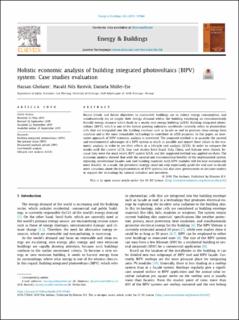| dc.contributor.author | Gholami, Hassan | |
| dc.contributor.author | Røstvik, Harald Nils | |
| dc.contributor.author | Müller-Eie, Daniela | |
| dc.date.accessioned | 2023-01-24T13:57:33Z | |
| dc.date.available | 2023-01-24T13:57:33Z | |
| dc.date.created | 2019-09-20T18:47:08Z | |
| dc.date.issued | 2019 | |
| dc.identifier.citation | Gholami, H., Røstvik, H. N., & Müller-Eie, D. (2019). Holistic economic analysis of building integrated photovoltaics (BIPV) system: Case studies evaluation. Energy and Buildings, 203, 109461. | en_US |
| dc.identifier.issn | 0378-7788 | |
| dc.identifier.uri | https://hdl.handle.net/11250/3045894 | |
| dc.description.abstract | Recent trends and future objectives in sustainable buildings are to reduce energy consumption, and simultaneously try to supply their energy demand within the building employing an environmentally friendly energy resource which leads to a nearly zero energy building (nZEB). Building integrated photovoltaics (BIPV), which is one of the fastest growing industries worldwide currently, refers to photovoltaic cells that are integrated into the building envelope such as facade or roof to generate clean energy from sunshine and is the most remarkable technology to contribute to nZEB purposes. In this paper, an innovative approach of BIPV economic analysis is presented. The proposed method is to quantify the societal and environmental advantages of a BIPV system as much as possible and import these values to the economic analysis in order to see their effects in a lifecycle cost analysis (LCCA). In order to compare the results with the current LCCA, four case studies from Brazil, Italy, China, and Bahrain were chosen, because they were the most recent BIPV system LCCA, and the suggested method was applied on them. The economic analysis showed that with the societal and environmental benefits of the implemented system, replacing conventional façades and roof building materials with BIPV modules will become economically more feasible. As a result, the presented strategy could not only expectantly guide the end user to decide more conscious about the implementation of BIPV systems but also steer governments or decision-makers to support the technology by rational subsidies and incentives. | en_US |
| dc.language.iso | eng | en_US |
| dc.publisher | Elsevier | en_US |
| dc.rights | Navngivelse 4.0 Internasjonal | * |
| dc.rights.uri | http://creativecommons.org/licenses/by/4.0/deed.no | * |
| dc.title | Holistic economic analysis of building integrated photovoltaics (BIPV) system: case studies evaluation | en_US |
| dc.type | Peer reviewed | en_US |
| dc.type | Journal article | en_US |
| dc.description.version | publishedVersion | en_US |
| dc.rights.holder | The authors | en_US |
| dc.subject.nsi | VDP::Teknologi: 500 | en_US |
| dc.source.pagenumber | 11 | en_US |
| dc.source.volume | 203 | en_US |
| dc.source.journal | Energy and Buildings | en_US |
| dc.identifier.doi | 10.1016/j.enbuild.2019.109461 | |
| dc.identifier.cristin | 1727411 | |
| cristin.ispublished | true | |
| cristin.fulltext | original | |
| cristin.qualitycode | 2 | |

